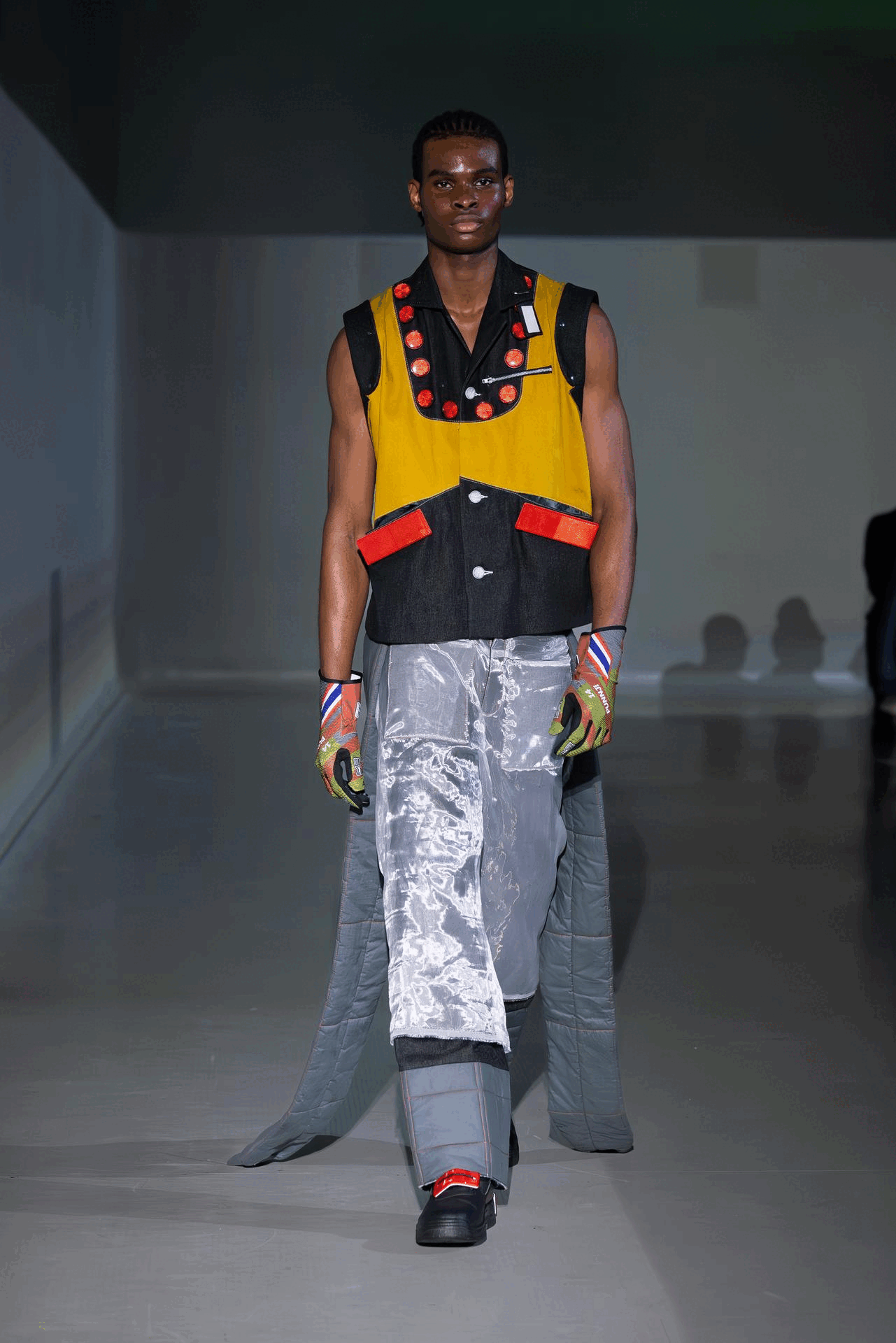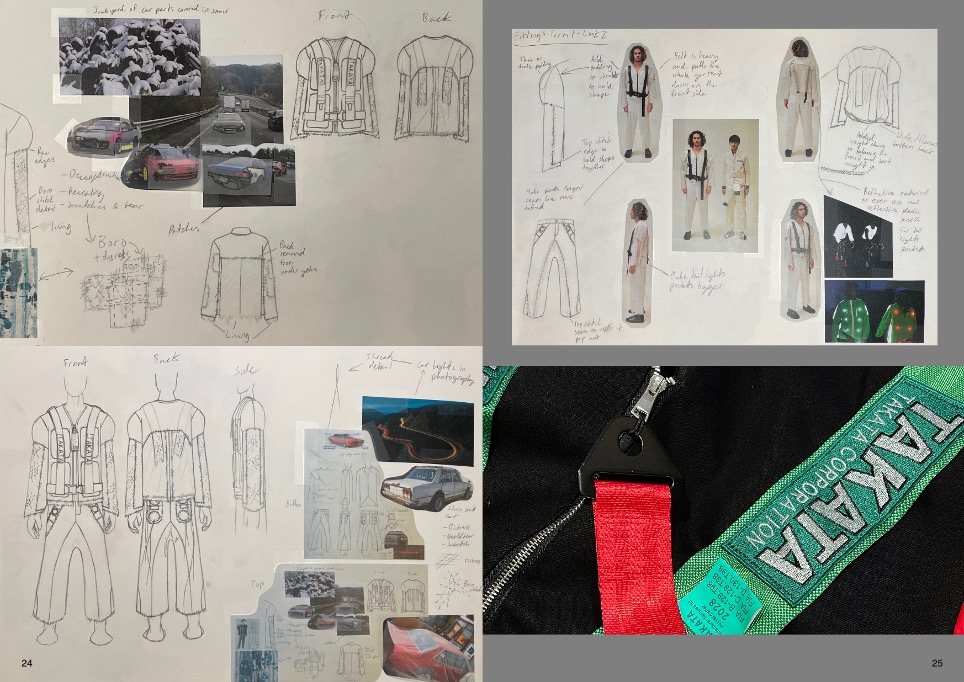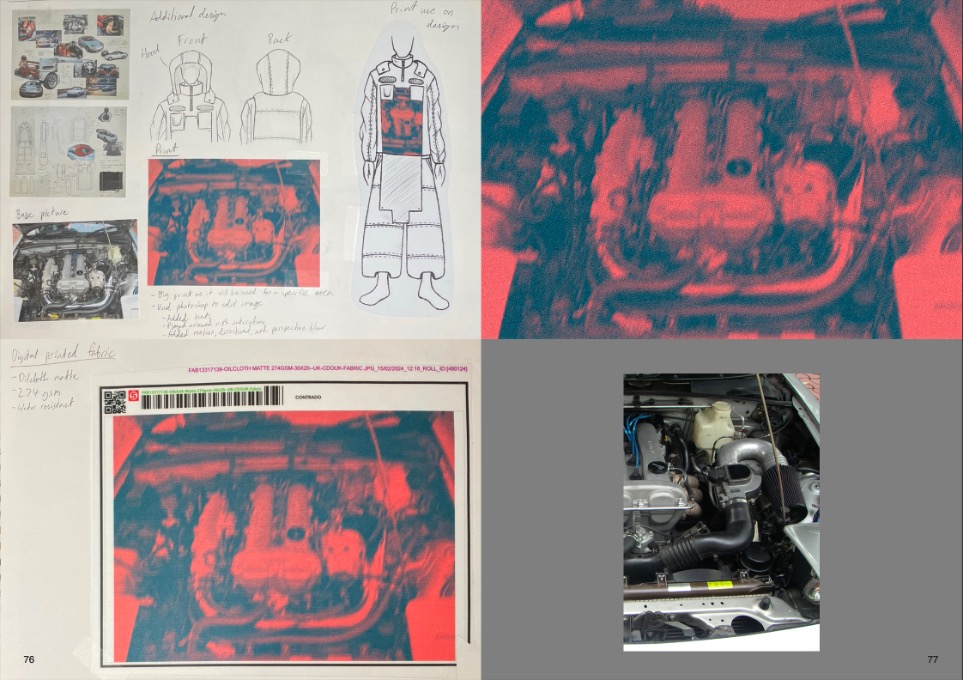


Racing gear is back. But what does it mean for emerging designers who are rethinking fashion through function, identity, and cultural relevance?
Motorsport aesthetics are no longer confined to the racetrack. For a new generation of fashion designers, racing gear and utilitarian elements are being reclaimed as cultural symbols—tools that help navigate identity, performance, and purpose in shaping the future of fashion. Here’s why it matters now.
How Emerging Designers Are Reinventing Motorsport Fashion
Once confined to the racetrack, motorsport gear is now making its way onto the runway. This fashion crossover is evident in the work of Punn Viravaidhya, a student at Istituto Marangoni London and an emerging designer. His graduate collection draws on the bold colours, sleek silhouettes, and cultural energy of Japanese race car culture. Viravaidhya reinterprets racing gear through a modern lens, fusing functionality, performance, and identity into a fashion-forward statement.
His work raises an intriguing question about graduate fashion collections, which have increasingly embraced both utilitarian aesthetics and motorsport influences in recent seasons. True creativity often flourishes when designers are free from marketing constraints or brand directives, which is typically the case during academic years. As a result, this recurring theme may reflect a deeper cultural undercurrent, one that remains untainted by the pressure to conform to fleeting micro-trends or to meet short-term commercial goals.

Looks from The State of Being Distinct, the graduate collection by Punn Viravaidhya, emerging fashion designer from Istituto Marangoni London
So, why are workwear and racing gear re-emerging as significant influences for Gen Z and Millennial designers shaping the future of fashion? And more importantly, what do these influences signify today, and how are they being reinterpreted for a new generation? To explore this, we spoke with Viravaidhya, whose vision embodies this shift. One of ten graduates selected to walk the 2024 Istituto Marangoni London fashion show, he became the first to secure a spot at the London Fashion Week 2025 event at the W1 Curates Flannels flagship store on Oxford Street.
Bikercore and Racing Style: Fashion’s Fastest-Rising Trend
Fashion has now fallen hard for bikercore, a trend that shows no signs of slowing down. What started as a niche aesthetic has surged into the mainstream, transforming racing suits, gloves, and boots—once exclusive to high-speed tracks—into essential streetwear staples.
Designers like Marc Jacobs, who began exploring motorsport influences as early as 2014, and Tommy Hilfiger, who followed suit around 2018, have helped pave the way by channelling the adrenaline and edge of the racing world into both streetwear and high fashion. However, it was Ferrari that took the trend to the next level with a striking ready-to-wear debut in 2021. Designed by Istituto Marangoni alumnus Rocco Iannone, the collection was inspired by the sleek lines of Ferrari cars. Trench coats, bomber jackets, parkas, and loose-fitting trousers blended high fashion with Ferrari’s signature Scuderia colours: red, yellow, and blue— creating a bold visual statement rooted in speed and power. Equally notable was Honda’s participation at Paris Fashion Week, showcasing bold bikercore apparel that merged classic moto heritage with haute couture.
Punn Viravaidhya at graduation fashion show. His research is deeply rooted in Japanese race culture
Fast forward to today, and the motorsport-fashion crossover is accelerating even further. Louis Vuitton has recently announced a 10-year sponsorship deal with Formula 1, cementing the sport’s influence on luxury fashion. Meanwhile, F1 star Lewis Hamilton is a key figure in this fusion; his appearance at the 2025 Met Gala, in his role as co-chair, underscores motorsport’s significant place in contemporary style.
Graduate Collections Embracing Utilitarian and Motorsport Codes
Seeking to understand how emerging fashion designers are innovating within this trend, we spoke with Punn Viravaidhya, who explained that his approach to workwear involves reimagining it using fresh pastel palettes. His designs reflect WGSN trends and are characterised by clean, utility-inspired styles that prioritise functionality and comfort for everyday wear.
With a focus on singularity, imagination, and inventiveness at the heart of his work, Punn’s design draws inspiration from his lifelong passion for modified Japanese car culture, transforming it into a creating exploration of uniqueness, deconstruction, and reinvention.

Design development from Punn Viravaidhya’s portfolio
Punn likens fashion design to an extension of automotive engineering, suggesting that just as car enthusiasts modify their vehicles to express individuality, he approaches garment-making in much the same way, deconstructing and reconstructing elements inspired by the anatomy of cars. His collection is a tactile homage to the spirit of customisation, incorporating unconventional materials such as car seat fabric, carbon fibre weave, car cover textiles and reflectors, resulting in a striking fusion of function and form.
At the core of Viravaidhya’s work is a mechanical dissection process. “I like researching from pictures, breaking them down into fragments, composing collages, and translating those elements into garments,” he explains. This method results in designs that reflect both the sleek aggression of Japanese racing machines and the utilitarian ethos of traditional Japanese workwear.
The garments made from car seat fabric embody this duality by combining industrial-strength textiles with the clean, minimalist lines of samue and tobi trousers, traditionally worn by Japanese artisans and construction workers.
The so-called Racing Suit/Vest look incorporates racing harnesses and aerodynamic panelling, while the Exhaust Manifold style is inspired by the intricate twists and curves of high-performance exhaust systems.

Design development from Punn Viravaidhya’s portfolio
Punn’s fascination with Japanese car culture is deeply personal. He shares, “Ever since I was a child, I was always surrounded by cars. My father’s Mazda MX-5 NA was my first real exposure to that world”.
Central to his collection is the concept of singularity, which is rooted in the idea that car modifications reflect the unique identity of their owners. Each aspect of customisation serves as a metaphor for how clothing can embody personal expression.
From Cars to Couture: How Engineering Inspires Fashion Innovation
Fabric research plays a crucial role in translating automotive elements into wearable fashion. In the work of this emerging designer, mesh patterns commonly found in car grilles are reinterpreted through layered textiles that mimic the dynamics of airflow. Car covers inform draping techniques that allow the garments to stand out—both literally and metaphorically—much like a customised car on the streets of Tokyo.
Punn Viravaidhya’s debut collection serves as a commentary on the relationship between fashion and function, as well as tradition and modernity. By repurposing materials and reimagining silhouettes, this up-and-coming designer challenges the boundaries of what fashion can achieve.
Punn is now pursuing an MA in Fashion Business at Istituto Marangoni London, further expanding his design foundation into the strategic aspects of brand management. He’s a designer to watch, unafraid to shift gears as he pushes beyond convention and into the unexplored intersections of creativity and commerce.
Silvia De Vecchi
Librarian, London



